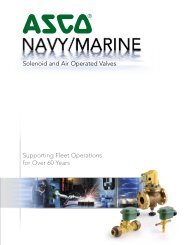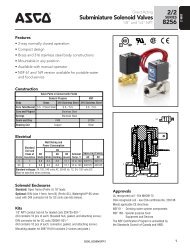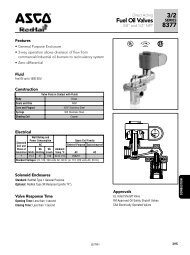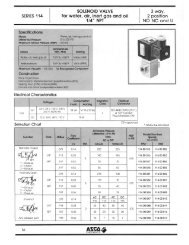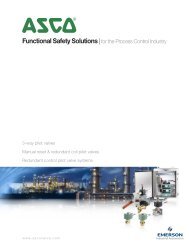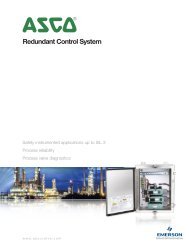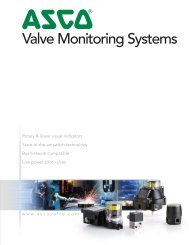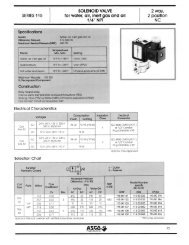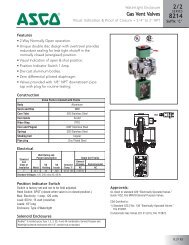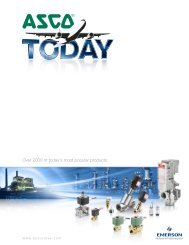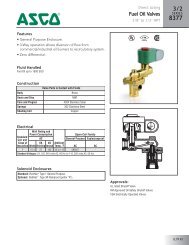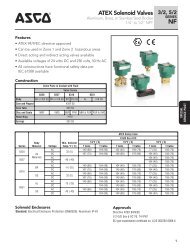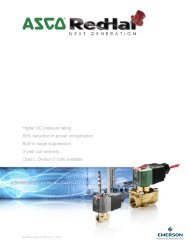Seven things you must know before selecting ... - ASCO Valve Inc.
Seven things you must know before selecting ... - ASCO Valve Inc.
Seven things you must know before selecting ... - ASCO Valve Inc.
Create successful ePaper yourself
Turn your PDF publications into a flip-book with our unique Google optimized e-Paper software.
<strong>Seven</strong> <strong>things</strong> <strong>you</strong> <strong>must</strong><strong>know</strong> <strong>before</strong> <strong>selecting</strong>solenoid valves for <strong>you</strong>rreverse osmosis systemby Anne-Sophie Kedad-Chambareau,Product Marketing Manager, <strong>ASCO</strong>Roy Bogert, Senior Product Engineer, <strong>ASCO</strong>David Park, Senior Product Engineer, <strong>ASCO</strong>A White Paper From <strong>ASCO</strong>
IntroductionMembrane-based reverse osmosis (RO) filtration systems offer valuable service in a widevariety of industrial and commercial settings. They purify water, improve taste, and providesavings in food and beverage processing; increase energy efficiency in boilers; andsupply a range of other benefits in applications from water jet cutting, vehicle washing,and humidification to restaurant and grocery use.One important component of these systems, typically used at several critical points, is thesolenoid valve. Design engineers working for original equipment manufacturers (OEMs)face multiple options — and issues — when <strong>selecting</strong> these complex, highly engineereddevices for their systems.Beyond the usual considerations of correct sizing and wattage, experienced designersare aware that many current models may exhibit worrisome performance problems, aswell as difficulties relating to certifications, availability, ease of assembly, and support,among others.Fortunately, valve technologies are now available that avoid many or all of these problems,while providing significant benefits for OEM and end user alike. This report guidesdesigners and specifiers in choosing the right valve to make a major positive impact onbudgets, equipment life, and time to market.1What <strong>you</strong> <strong>must</strong> <strong>know</strong> about the valve <strong>you</strong> selectDoes it have the proper certifications?OEMs <strong>must</strong> accommodate new regulations in many parts of the world, including thosespecifying the use of lead-free products and more. For instance, most current U.S. plumbingcodes and state drinking water regulations demand that RO equipment for potablewater applications meets NSF 61-G leachate and lead-free requirements.2
2However, regulations and their means of adoption have been changing with relative rapidity,leaving many OEMs confused — and concerned. Caution is advisable. In specifyingcomposite valves for these RO systems, pay close attention to how prospective vendorsstate their products’ certification status.Some don’t mention NSF certification at all. Likely conclusion: the given product does notpossess it. This should be a red flag. It could legally preclude use of an OEM’s RO systemincorporating the vendor’s valve in certain North American localities such as in Californiaor Vermont. Furthermore, S. 3874, the “Reduction of Lead in Drinking Water Act,” will beeffective in January 2014 all across the USA. This act modifies the Safe Drinking WaterAct (amended in 1986), that defines “lead free” with regard to pipes, pipe fittings, plumbingfittings and fixtures. Other vendors may claim their product “complies” with a certainstandard. However, untested and uncertified compliance does the OEM little good in jurisdictionsthat may require the certification itself. Design engineers should look for valvesthat possess all the certifications necessary for <strong>you</strong>r intended application. For example,the new 212 Series composite valves from <strong>ASCO</strong> are tested and certified by NSFInternational (accredited by ANSI and the Standards Council of Canada) for all applicableratings. <strong>Valve</strong>s suitable for applications such as water jet cutting, vehicle washing, boilers,and humidification systems are tested and certified to NSF 372 (weighted average leadcontent for lead-free applications using industrial purified water). For potable water applicationssuch as food and beverage processing and restaurant steamers, relevant modelsare tested and certified to NSF 61 Annex G (for drinking water leachate requirements, andlow lead content) and NSF 169 (for special-purpose food equipment and devices). They’realso tested and certified to NSF 42 for drinking water treatment units — aesthetic effects.Will it be available when needed?Most OEM designers <strong>must</strong> depend more and more on the ready availability of compositevalves for their RO systems. Today’s lean manufacturing methodologies demand it,as do the lower work-in-process inventory requirements now common in OEM operations.But just when it’s become more important than ever, availability has proved an Achillesheel for a number of composite valve vendors. Their response to ongoing doldrums inthe world economy has included cuts in staffing and limits in their own inventories ofmaterials and components — all efforts to reduce capital requirements. Unfortunately,these measures often result in long lead times and uncertain scheduling for their customers,threatening <strong>you</strong>r assembly target dates, or prolonging plant downtimes.When evaluating valve makers, designers and purchasing managers <strong>must</strong> take a goodlook at availability. Does the supplier have established quick-shipment programs? Do3
3the programs cover <strong>you</strong>r locality? Are the composite valves <strong>you</strong> want — as well asother products <strong>you</strong> might buy from the same company — included in those programs?What lead times and delivery schedules do they claim? Each vendor with such a programtracks its on-time percentages; ask about its record of meeting shipment datesfor those commitments.Is it reliable?Certain other characteristics <strong>must</strong> also be carefully considered when <strong>selecting</strong> compositevalves for RO applications. They can have a real impact on product reliability, maintenancecosts, and service life.Unfortunately, it’s not uncommon for some composite valves used for these applications toleak — even after only a few thousand operating cycles. This issue may be caused simplyby poor connection system design (see next section). However, it can also be due to outof-specpressure or thermal stress on the connection or other parts of the valve.Some vendors offer composite valves that simply aren’t designed or rated for the higherpressures and temperatures inherent in some RO system applications. The vendor may ormay not consider these limits when selling the valve. Ultimately, it behooves the designerto make sure the valve’s ratings are adequate for the job.Passing the testHeadquartered in Gurnee, Illinois, CorriganCorporation of America is a leading U.S.manufacturer of high-quality systems forproduce misting, humidity, and water filtration.To avoid corrosion, water inlet controlon its three major product lines — includingthe HyperSoft reverse osmosis system —is performed by a composite-bodiedsolenoid valve.“For years, we had unbelievable supplyproblems with this valve type,” recalls PaulJones, Corrigan’s vice president of engineering.“Moldings would leak, or plungerassemblies would fail, or the wrong productwould be shipped, or the maker wouldmiss our deadline.”“We grabbed the chance to beta test thenew <strong>ASCO</strong> composite valve,” says MikeCorrigan, president and CEO. “It can takethe pressure. We’re operating up to 70 psi.In addition, the valve has the NSF rating.Corrigan systems are NSF-certified, and it'svery important that our valves also havethat certification. Health departments andplumbing inspectors throughout NorthAmerica recognize NSF and never have anissue with our equipment. And the valvesare proven reliable up to 1 million cycles.We love that. We’re seeing maybe 100,000cycles per year. So our equipment will lastlonger than the whole grocery case,"Corrigan said.“We’ve had on-time delivery since thecomposite valve launched. I’d say we’veput in 700 of them already. And every valveout there has performed," he said.4
45As a protective measure, many designers choose valves with ratings that slightly exceedlevels expected in applying a given piece of equipment. The high points for this categorywould currently be represented by the <strong>ASCO</strong> composite valves available in ½-inch and¾-inch line sizes, with durable thermoplastic bodies rated for pressures to 150 psi andtemperatures to 180° F.Can it connect easily and securely?Frankly, connections can be a major concern when specifying composite valves for RO work.Many design engineers report frustration with valves utilizing traditional NPT and solventbond connections, for example. These may require considerable trouble and expense inequipment design, installation, and assembly. (See next section.)The logical alternative would be quick-connect valves. But experience has left manydesigners uneasy about the security of various quick-connect solutions available to date.Simply put, they can leak.Fortunately, designers now have a better choice. Ongoing development efforts haveproduced a new type of quick-connect technology. <strong>ASCO</strong>'s patent pending FasN universal connection system, introduced on its newest composite valves, provides aninnovative turn-and-lock solution. Like other quick-connect systems, it’s said to maximizeease and speed. But unlike some previous systems, it also prevents leaks.FasN-equipped valves can be used with all three types of standard valve-to-pipe endconnections: threaded pipe types with NPT thread; CTS or PEX tubing with turn-and-lock;and PVC with solvent bond. With all three types, users report highly secure, no-leak connections.So designers previously wary of such connections can now specify a quickconnectsolution without worry.Is it easy and economical to design and install?Several situations can make integration of valve components into purified water andreverse osmosis filtration systems especially difficult and time-consuming.Often, desired performance characteristics are maximized by using, for example, PEXtubing in one part of an RO system, and PVC or copper (CTS) tubing in another part.However, this requires the design, specification, purchase, assembly, and installation ofcustom fittings or adapters, at the place or places where components of differing typesor materials <strong>must</strong> come together. When multiple such situations exist in a single piece ofequipment, or in cases where OEMs <strong>must</strong> turn out high volumes of such equipment,added costs and lost time can be substantial.5
Another issue may arise where composite valves threaded for NPT connection <strong>must</strong> beassembled or installed. The concern here: cracking.When a piping assembly is put together, the valve is screwed onto the pipe with a giventorque or pressure, to the tightness required for a good seal. However, this procedureusually will not leave the valve aligned correctly, for instance in an upright position, forproper mounting. So the valve <strong>must</strong> then be further rotated into its final position.Problem: this further tightens the valve. With brass or stainless steel valve bodies, suchovertightening does no harm. But depending on the degree of rotation involved, the thermoplasticthreads of composite models may easily split or crack under the increasedstrain — ruining the entire valve. This cracking may only be evident when the system ispressurized (worst case: in the field), after which the entire component <strong>must</strong> bedissembled and replaced.(Note that some models include stops to prevent overtightening. However, this presentsassemblers with almost equally aggravating problems: they <strong>must</strong> then search for someother point in the system that can be tightened to compensate.)In critical assemblies using composite valves, then, cautious engineers <strong>must</strong> often go to thetrouble and expense of specifying two extra parts per valve, adding unions to each end.Where the latest-technology connections are used, both these problems are resolved.For instance, <strong>ASCO</strong> composite valves with FasN connectors are proving to have theindustry’s greatest design flexibility, most rapid assembly, and lowest cost. They’re currentlythe only models on the market equipped with three possible varieties of union couplingon each end — even on NPT-threaded models. So piping and valves of disparateConnecting to savingsEspecially in a high-production OEM environment,cost differences can be substantialwhen using newer technology versusconventional solutions. Example: <strong>ASCO</strong>composite valves with FasN connectionsdemonstrate a measured labor savings of35 seconds per valve, plus much greatermaterials savings depending on which typeof extra fitting or adapter would otherwisebe required. Assuming 1000 RO units turnedout per year, with 3 valves per unit, a studycomparing FasN connection to NPT-threadedvalves on PVC piping calculated savings of$15,790 per year. Another — versus NPTthreadedvalves on PEX tubing — showedsavings of $40,930 per year!6
67types and materials may be connected quickly and easily, with fewer piping accommodationsand no custom fittings or adapters. Additionally, each NPT end coupling can bescrewed onto the pipe with the required torque for a proper seal. The valve is thenrotated freely to the proper position, and the union joint quickly and easily secured.Is it available in both normally closed and normally open versions?Even leading vendors may offer composite valves only in normally closed versions. Thiscan force OEM designers to make unwelcome equipment compromises. For example,they may have to purchase expensive diverter valves to compensate for this lack ofnormally open models.Look for a vendor that offers both normally open and normally closed composite solenoidvalve versions. This can furnish needed design speed and flexibility, while simplifyingsourcing with fewer part numbers to keep in stock.It may even save money. Some customers buy a normally open plus a normally closedvalve and wire them in series, gaining the functionality of a diverter valve for less cost.Does it come with the right support?When <strong>selecting</strong> <strong>you</strong>r valves for an RO system, don’t stop at hardware characteristics.Evaluate potential buys also on the level of support their vendors can offer.Some suppliers put more energy and resources than their competitors into maintaining thequality of their support. Other vendors have spotty coverage due to basic geographicaldisadvantages. With North American customers, for example, products made by Asian orEuropean manufacturers naturally face greater logistical challenges. Customers may findit takes considerable time to get answers, technical fixes, and onsite service or training.Essentially• The solenoid valve is more important than<strong>you</strong> might think to the success of a reverseosmosis filtration system.• <strong>Valve</strong>s are not created equal when it comesto issues such as availability, connectionand installation, or reliable performancewithout leaks.• Fortunately, some newly improved valvetechnologies can save trouble, time,and costs.7
Additionally, satisfactory support should now extend beyond phone calls and site visits.The Web has greatly expanded support possibilities for companies that choose to usethem. Does the prospective valve vendor’s Web site provide good technical informationon the product in question? Does it include specification assistance with sizing and applicationissues? How about 3-D engineering drawings and similar enriched content?For maximum effectiveness, favor vendors with global technical and application supportcapabilities as well as extensive Web presences. Then investigate how well a givenvendor provides local support in <strong>you</strong>r area.ConclusionConventional composite valves have presented several challenges to specifiers anddesigners. These have ranged from business concerns including availability and supportto technological issues and connection drawbacks.However, some vendors, using new composite valve technologies, can offer notable benefitswhen improved valves are specified for membrane-based filtration functionality inreverse osmosis systems. These advantages include up-to-date certifications; ready availability;high reliability even in challenging applications; quick, secure connection; ease ofuse and ensured savings in design, assembly, and installation; a choice of open andclosed versions; and comprehensive, resource-rich support. For the OEM, they all add upto greater cost savings, longer ensured equipment life, and shorter time to market.Compare widely and evaluate carefully. You can find a composite solenoid valve thatoffers the right reliability and performance for <strong>you</strong>r equipment’s unique application.
Global contactswww.ascovalve.com<strong>ASCO</strong>Location Phone E-mailWorld headquarters (U.S.A.) (1) 800-972-<strong>ASCO</strong> (2726) info-valve@asco.comCanada (1) 519-758-2700Australia (61) 2-9-451-7077Brazil (55) 11-4208-1700Mexico (52) 55-3640-0200France (33) 1-47-14-32-00Germany (49) 7237-9960United Kingdom (44) 1695-713600China (852) 2-343-8580Singapore (65) 6556-1100Japan (81) 798-65-6361<strong>ASCO</strong>, Right Now, and FasN are trademarks of<strong>ASCO</strong> <strong>Valve</strong>, <strong>Inc</strong>. The Emerson logo is a trademarkand service mark of Emerson Electric Co.All other brands may be trademarks of theirrespective holders.© 2013 <strong>ASCO</strong> <strong>Valve</strong>, <strong>Inc</strong>.All rights reserved.Printed in USA04/13 1231036



